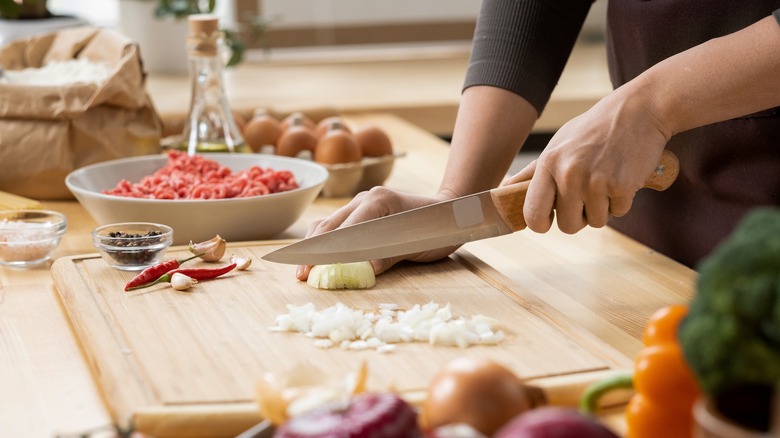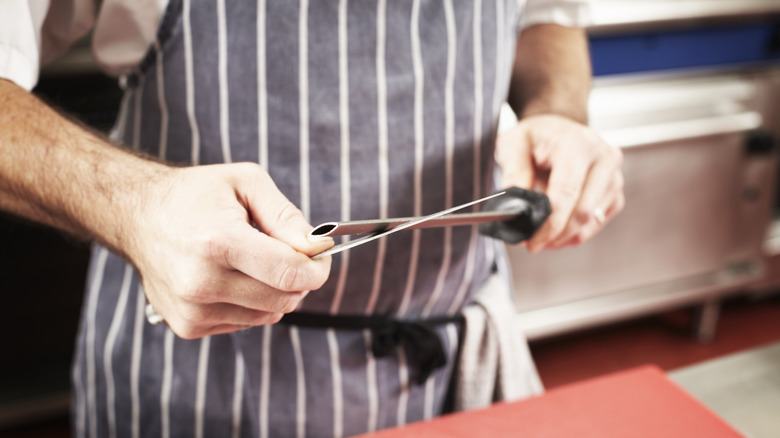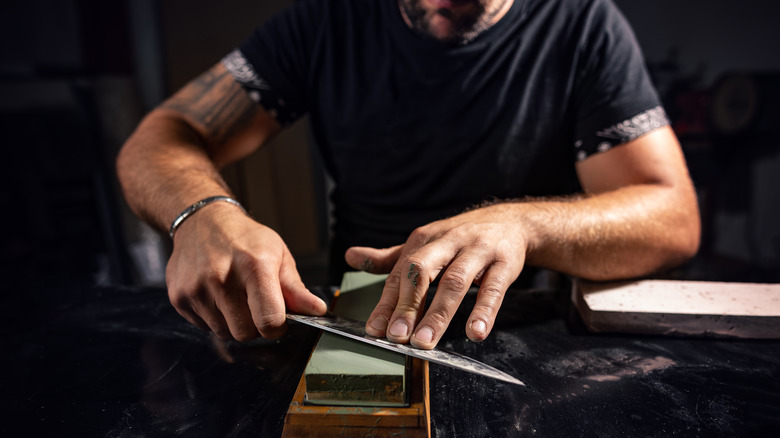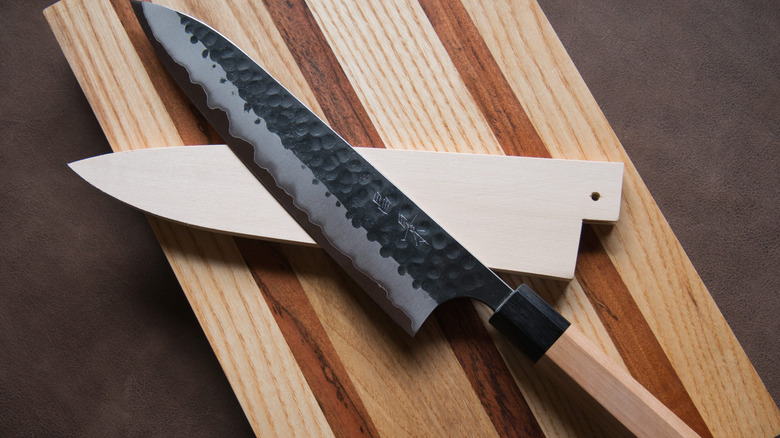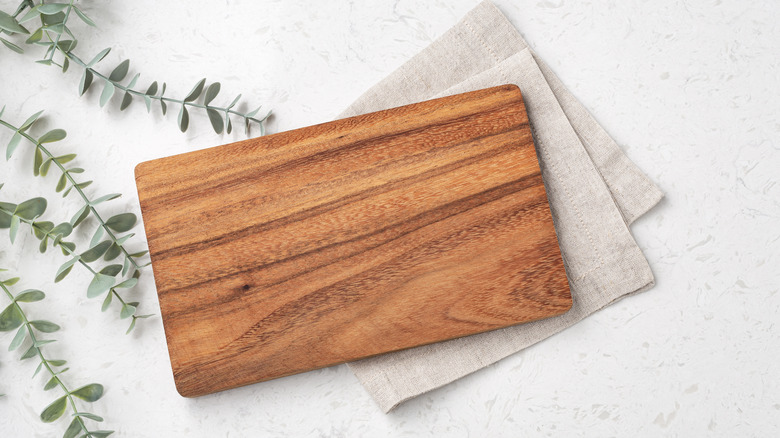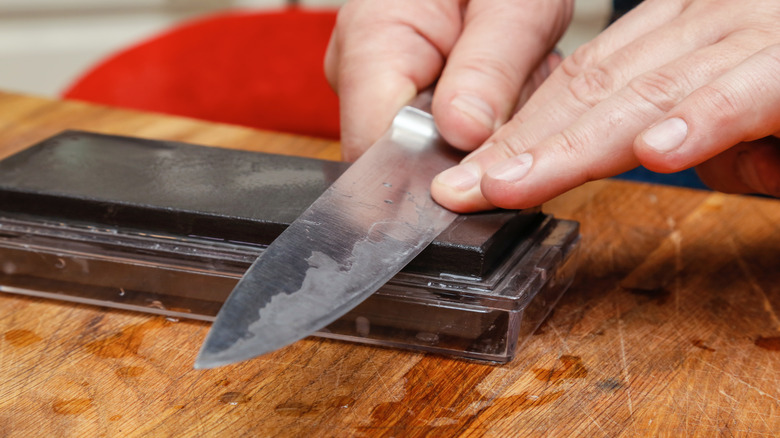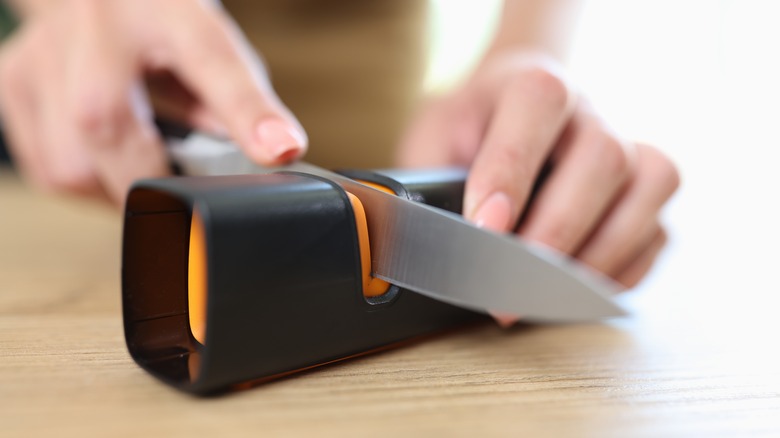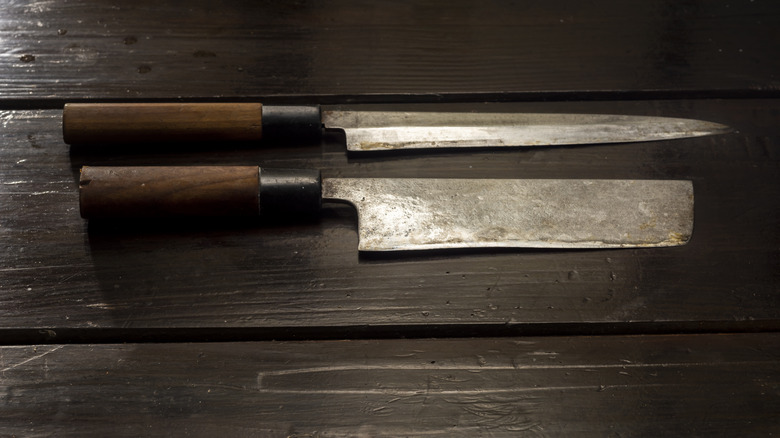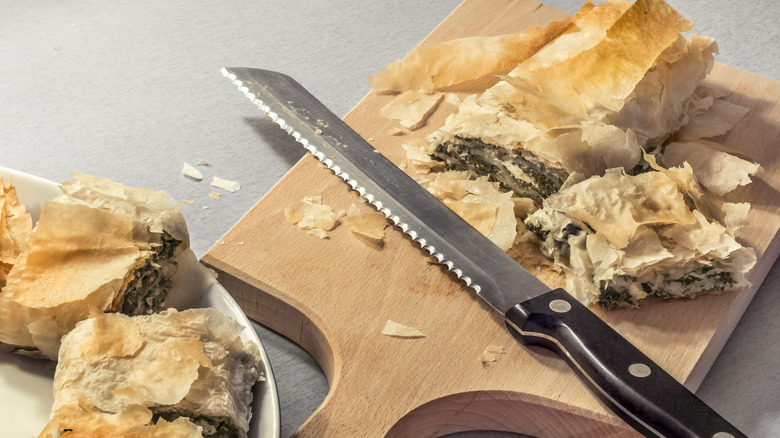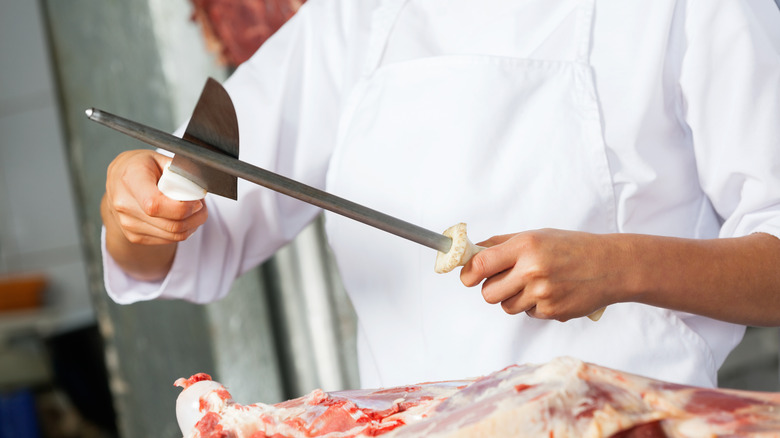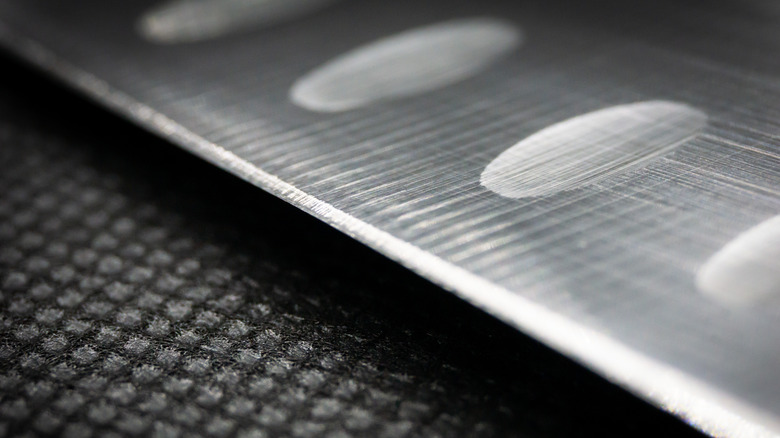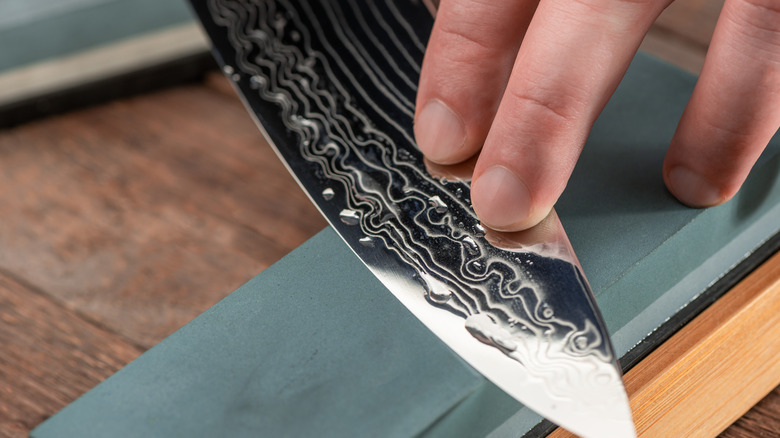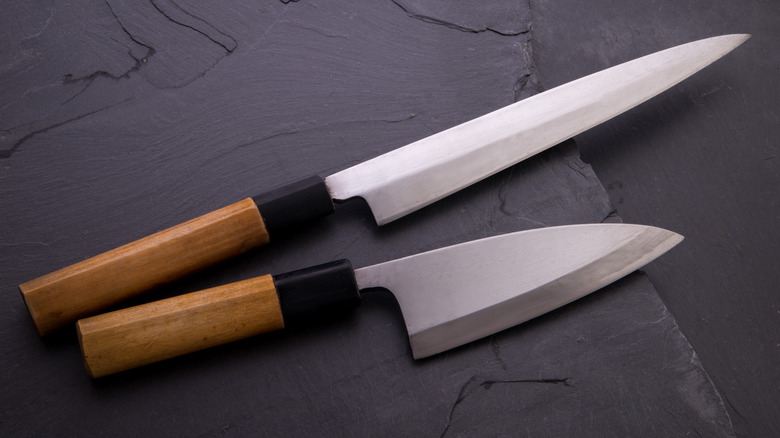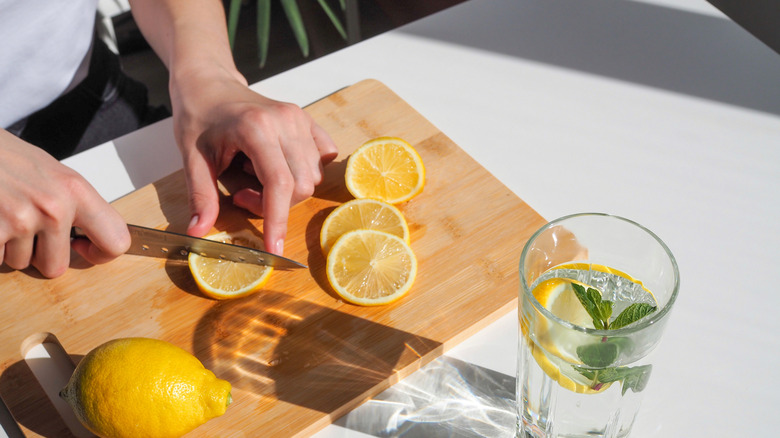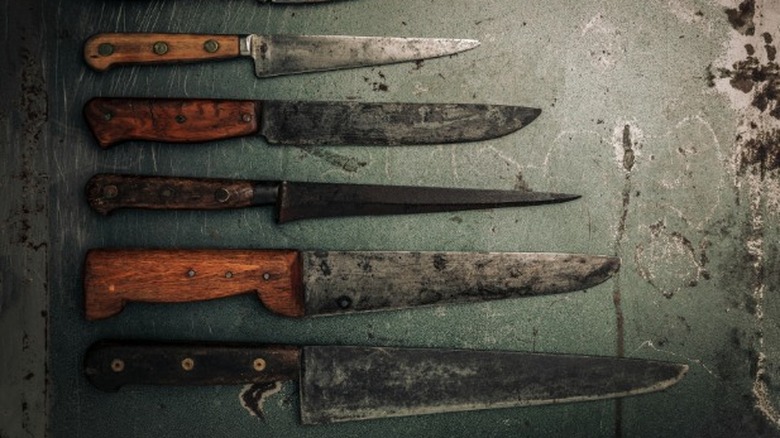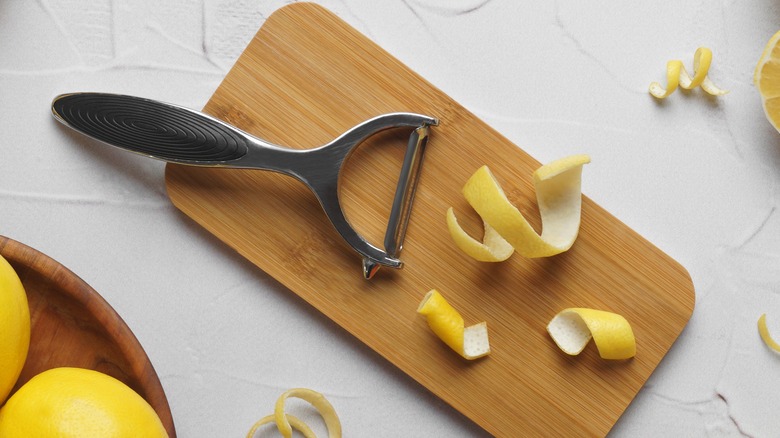Everything You Need To Know About Keeping Your Knives Sharp
A good chef is only as good as his tools, and the foundation of all cooking begins with the chef's knife. Contrary to popular belief, a more expensive knife doesn't necessarily mean a sharper edge. Bargain knives from a big box store can be just as sharp as pricey knives made of specialty materials if you know how to sharpen and hone correctly. Even if you don't necessarily consider yourself the next Gordon Ramsay, knowing about knives can save time, money, and trips to the E.R.
We sat down with master sharpener Craig Field of Carbon Knife Co. in Denver, Colorado, to find out more about how to keep the sharpest knives possible. "Over time, with use, a knife's edge will become fatigued, misshapen, and won't offer the same cutting experience anymore," says Field. "Dull knives are not only boring but much more dangerous to use." With that in mind, let's dive into the nitty-gritty on everything you should know about knives and sharpening.
Know when to hone
Honing and sharpening are often confused with one another, and while both do add to the feeling of sharpness on a blade, sharpening should be reserved for use only when necessary. "The process of 'sharpening' a blade entails removing a small amount of steel from the cutting edge of the knife and recreating a sharp new edge bevel," says Field. This can be done on a mechanical grindstone, a whetstone, or using a manual pull-through sharpener.
Honing, on the other hand, is done using honing steel. It does not remove any metal from the blade but rather straightens the edge, resulting in a sharper and more precise feel. Honing can prolong the time between sharpenings and should be done often. Because no material is removed, you can't hone a knife too much. Try to do it before every major cooking project or about once a week.
Learn how to use a whetstone
According to Field, one of the oldest ways to sharpen a knife is still the best way. Sharpening a knife on a stone requires a whetstone, but what exactly is a whetstone? Technically, a whetstone is any kind of stone block that can be used to sharpen a knife. The most common kind available today is made of a synthetic material designed to have a certain level of coarseness or grit, just like sandpaper. Also, like sandpaper, coarser grits can be used for heavier jobs, and you graduate down to finer grits to fine-tune the edge.
While this method can take a bit of practice, Field says he is confident that anyone can learn. "Whetstone sharpening is the most gentle process allowing you to remove just enough steel to make your blade sharp again," says Field. "Whetstone sharpening is also extremely versatile; no matter what type of knife or sharpening angle, it can be done!"
Invest in a knife guard
Are you storing your knives in a drawer, mixed with a bunch of other cooking tools? Stop! This is one of the most common ways home cooks dull their knives, other than washing them in the dishwasher. Technically, any time the knife touches anything, it can cause some of the microscopic misalignment that contributes to knives feeling dull. As they say, an ounce of prevention is worth a pound of cure, and in this case, one of the best ways to keep a sharp knife is to prevent it from dulling in the first place.
While wooden knife blocks or magnetic knife strips work fine, professional chefs often use dedicated knife guards or wooden sayas. Only these can protect the edge from damage and the edge from damaging you, no matter where you store your knife. No matter what you choose, make sure your knife is clean and dry before storage.
Use the right cutting board
Wood cutting boards aren't just for looks, and according to Thomas Keller, they are the foundation of all food prep. The material you cut on plays a large role in how sharp your knife stays. "The biggest culprit in a dull edge is not always your knife, but more so your cutting board!" says Field. "We recommend finding a cutting board that is composed of a softer material like Japanese hinoki, soft rubber, or end grain wooden boards. These materials act like insoles for your knife's edge and absorb the blow when cutting." Make sure to wash and dry your cutting board, and definitely stop drying it lying down.
Stay away from cutting boards made with harder wood, like bamboo, and never use a stone or glass cutting board. Even harder plastics can have an effect, so if you have one that you use for everything, try and use it only when absolutely necessary.
Sharpen often (but not too often)
Now that you know about sharpening your kitchen knife, the question that remains is how often. How often you sharpen your kitchen knives can vary depending on how much you cook. Professional cooks and chefs typically sharpen their knives every 2 to 3 months, but home cooks may not need to do it nearly as frequently.
Knowing exactly when to sharpen your knife can be tough to identify if you aren't experienced. Luckily, there is a sound that's a sign it's time to sharpen your knives. Maybe you've never thought twice about that crunching sound when chopping vegetables, but a super-sharp knife should glide through onions and peppers without making much of a sound. If you feel resistance as you try to cut and hear some crunching, it's probably time for a sharpening. Other veggies can help test the sharpness of your knives, like tomatoes. If the blade easily slices through the skin, it's plenty sharp.
Ditch the sharpener
It might seem tempting to order a manual sharpener for home use. They are cheap, easy, and even high-quality knife companies sell them. So what's the problem? Field told us: "The only thing we generally never recommend is any of the power-assisted 'pull through' style sharpeners for home use. Depending on the type of knife or steel, these can remove too much material from your knife and sacrifice the overall life of your tools. We've seen some bad repair jobs in the past as a result of using these style sharpeners."
If you have to use one of these devices, understand that every use will shorten the overall lifetime of your knife. If you really need to sharpen your knife in a pinch, you are better off using a coffee mug, which can double as a sharpener. The coarse grit of the exposed ceramic is the perfect stone to help your edge get back to tip-top shape.
Japanese vs. Western Knives
Choosing the right knife can be a daunting process for many consumers. Not only are there tons of price points and materials to consider, but there is always the ever-present question of Japanese versus German or Western-style knives. The difference between the two styles of knives comes down to design, bevel, and in some cases, the metal used. Japanese knives often have a bevel of 10 to 15 degrees per side. These delicate knives are made for the fine type of knifework that Japanese food requires, such as slicing sashimi or thinly slicing radish.
While all knives are typically made of steel, German or Western knives are known to be made of much harder metal. With a bevel at 17.5 degrees, this style of knife will be easier to sharpen but will require it much more often. Japanese knives will hold an edge for much longer but may be more difficult to sharpen and more prone to chipping and breaking.
Don't skip your serrated
Serrated knives are essential for everything from slicing tomatoes to cutting bread. Many people are under the (incorrect) assumption that these knives can't be sharpened, but there is an easy trick for sharpening serrated knives. Simply start by looking for the blade's edge, located in the gullet, and determine which side the bevel is on. To the naked eye, you should be able to see that one side is flat while the other is angled. Once you have determined this, run a honing steel in between each tooth of the knife. After, run some sandpaper or the honing rod on the other side to make sure you have removed any metal burrs.
Removing the burrs is a step you should never skip when sharpening serrated knives. If you skip it, you could end up with those burrs in your food, something you never, ever want.
Use your steel the right way
Once you have determined that your knife needs just a quick hone and not a true sharpen, you will need to make sure you are honing the right way. Running your knife up and down the rod improperly can result in damage to the knife, which could be irreversible. The kind you get doesn't need to be expensive, and there are plenty of great options for less than $20.
Using a honing steel or honing rod is quite simple. First, grab your knife in your dominant hand and the honing steel in the other. Plant the tip of the steel onto a cutting board, using a towel for extra stability if needed. Starting at the hilt and moving towards the tip, run the length of the knife at a 15 to 20-degree angle down the steel. Make sure to do an equal number of times on each side, no more than 10 strokes total.
Know your bevel
The bevel is the angle where the edge of the knife comes to. This can be something like 15 degrees per side or something more severe, like 45 degrees on a single bevel knife. "Typically, kitchen knives are sharpened anywhere between 15-20 degrees per side," says Field. "Japanese knives that use purer steels with higher hardness can be sharpened at a bit lower angle and take on amazing sharp edges that stay sharp for much longer."
Before you begin to sharpen a knife yourself, you need to know which bevel, or you could risk ruining the edge completely. This information should be available from the manufacturer, or you can take your knife to a professional sharpener to have them help identify it. If you know but are intimidated by making sure that angle is maintained, there are handy angle guards designed to help make sure you don't mess this step up.
Rely on a professional
There's no shame in hiring a professional to sharpen your knives. Many professional chefs and cooks take their knives to be professionally sharpened, even if they could do it themselves to save time. Also, professional knife sharpeners are specialists in their trade and will often be much more knowledgeable about some of the more obscure nuances of sharpening.
Even if you have picked up a whetstone and learned how to do the process yourself, it's a good idea to stick to the pros for repairs and difficult jobs. Ultimately, the choice to take your knives to a pro sharpener will come down to geography and if one even exists in your area. Some places accept knives by mail for sharpening, which could be a good option if you can't find someone locally. The industry standard is about $1 per inch of knife, but this can go up and down depending on the knife and what needs to be done.
Don't think that price equates to sharpness
Knife salespeople and marketing experts would have you believe that a more expensive knife is a sharper knife. We've all seen the commercials on T.V. where spokespeople are whisking knives through tough vegetables or sawing through a phone book. The truth is that all knives come factory sharpened to roughly the same degree of sharpness. There are plenty of great knives that can be bought for less than $100.
Some of the factors you should consider when looking at higher-priced knives are things like material, weight, and design. Top-notch carbon steel knives are known for minimal wear, which means much more time between sharpening. If you want to upgrade your chef's knife, ashi hamono knives strike a good balance between quality design and fairly reasonable prices.
Avoid rust and acid on carbon steel
Even though carbon steel knives retain an edge longer, the blade is much more susceptible to rusting. While made of more durable material, stainless steel blades can also be damaged without proper care. A rusty knife is a dull knife, and you should take every possible measure to avoid rusting. Even slicing a few lemons can be enough to eat away at the blade's edge. Be careful whenever you are using your knife to cut citrus, and always wash and dry your knife thoroughly after each use.
Chef Dominique Crenn's simple tip for keeping your knives sharp is to simply wash and dry them immediately, as opposed to just tossing them in the sink. While it can be tempting to do, never put a knife in the dishwasher. The washing and drying cycles of the dishwasher can warp the handle and rust the blade, plus all that motion inside makes it more likely for the blade to bang against something that will dull it.
Pick the right material
The type of metal your knife is constructed from plays a huge role in edge retention and how easy or difficult it is to sharpen. The best type of metal for a chef's knife can vary depending on personal preference and what exactly you want out of your knife. Some of the most common materials are stainless steel, carbon steel, and Damascus steel. Stainless steel is, by and large, the most popular for its durability and resistance to corrosion.
Some chefs and cooking enthusiasts prefer carbon steel for its sharpness and edge retention, even though it requires more maintenance than stainless steel to prevent rust and discoloration. Damascus steel is made by layering different types of metals together, resulting in a distinctive, wavy pattern on the blade. Damascus steel is known for its durability, sharpness, and unique appearance, though some believe that the cool look doesn't necessarily equate to a better knife.
Don't forget the other tools
A knife isn't the only blade in your kitchen that needs to be kept sharp. Kitchen shears are essentially two single-bevel knives fastened together with a pin. There is a trick for sharpening kitchen shears, and it uses something you likely already have on hand. If you have started to notice a dullness in your kitchen shears, just cut through some aluminum foil. Fold a piece of aluminum foil about six layers thick, then cut it into several strips using the full length of the blade.
Vegetable peelers are much more simple to sharpen, and there's a trick that doesn't use any special tool. The same honing steel that can sharpen your knife's edge can bring your peeler back from the brink. If that doesn't work, take a metal nail file and run it between the gap in the peeler's blades. If that still doesn't work, you may need to invest in a new peeler.
